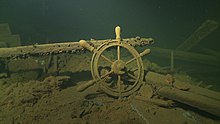
Back علم الآثار تحت الماء Arabic Sualtı arxeologiya Azerbaijani Подводна археология Bulgarian অন্তর্জলীয় প্রত্নতত্ত্ব Bengali/Bangla Arqueologia subaquàtica Catalan دێرین ناسی سووباکواتیک CKB Unterwasserarchäologie German Υποβρύχια αρχαιολογία Greek Arqueología subacuática Spanish Allveearheoloogia Estonian



Underwater archaeology is archaeology practiced underwater.[1] As with all other branches of archaeology, it evolved from its roots in pre-history and in the classical era to include sites from the historical and industrial eras.
Its acceptance has been a relatively late development due to the difficulties of accessing and working underwater sites, and because the application of archaeology to underwater sites initially emerged from the skills and tools developed by shipwreck salvagers.[2] As a result, underwater archaeology initially struggled to establish itself as actual archaeological research.[3] This changed when universities began teaching the subject and a theoretical and practical base for the sub-discipline was firmly established in the late 1980s.
Underwater archaeology now has a number of branches including, maritime archaeology: the scientifically based study of past human life, behaviors and cultures and their activities in, on, around and (lately) under the sea, estuaries and rivers.[4] This is most often effected using the physical remains found in, around or under salt or fresh water or buried beneath water-logged sediment.[5] In recent years, the study of submerged WWII sites and of submerged aircraft in the form of underwater aviation archaeology have also emerged as bona fide activity.[6]
Though often mistaken as such, underwater archaeology is not restricted to the study of shipwrecks. Changes in sea level because of local seismic events such as the earthquakes that devastated Port Royal and Alexandria or more widespread climatic changes on a continental scale mean that some sites of human occupation that were once on dry land are now submerged.[7][8] At the end of the last ice age, the North Sea was a great plain, and anthropological material, as well as the remains of animals such as mammoths, are sometimes recovered by trawlers. Also, because human societies have always made use of water, sometimes the remains of structures that these societies built underwater still exist (such as the foundations of crannogs,[9] bridges and harbors) when traces on dry land have been lost. As a result, underwater archaeological sites cover a vast range including: submerged indigenous sites and places where people once lived or visited that have been subsequently covered by water due to rising sea levels; wells, cenotes, wrecks (shipwrecks; aircraft); the remains of structures created in water (such as crannogs, bridges or harbors); other port-related structures; refuse or debris sites where people disposed of their waste, garbage and other items, such as ships, aircraft, munitions and machinery, by dumping into the water.
Underwater archaeology is often complementary to archaeological research on terrestrial sites because the two are often linked by many and various elements including geographic, social, political, economic and other considerations. As a result, a study of an archaeological landscape can involve a multidisciplinary approach requiring the inclusion of many specialists from a variety of disciplines including prehistory, historical archaeology, maritime archaeology, and anthropology. There are many examples. One is the wreck of the VOC ship Zuytdorp lost in 1711 on the coast of Western Australia, where there remains considerable speculation that some of the crew survived and, after establishing themselves on shore, intermixed with indigenous tribes from the area.[10] The archaeological signature at this site also now extends into the interaction between indigenous people and the European pastoralists who entered the area in the mid-19th century.[11]
- ^ "Underwater and Maritime Archeology in Latin America and the Caribbean". p. 21.
{{cite web}}: Missing or empty|url=(help) - ^ Akesson, Per. "A history of underwater archaeology". Nordic Underwater Archaeology. Archived from the original on 2018-12-09. Retrieved 2005-10-01.
- ^ Gibbins, David & Adams, Jonathan (2001). "Shipwrecks and maritime archaeology". World Archaeology. 32 (3): 279–291. doi:10.1080/00438240120048635. S2CID 37301382.
- ^ "How underwater archaeology reveals hidden wonders". Culture. 2019-08-02. Archived from the original on August 2, 2019. Retrieved 2020-09-16.
- ^ Muckelroy, K. (1978). Maritime archaeology. Cambridge University Press. ISBN 978-0-521-29348-8.
- ^ "Broken Wings". Western Australian Museum. Government of Western Australia. Retrieved 5 June 2015.
- ^ "Port Royal Project: Home".
- ^ University of Southampton. ":: University of Southampton". Archived from the original on 19 August 2007.
- ^ "The Scottish Crannog Centre".
- ^ "Zuiddorp (Zuytdorp) (1712/06) North of Kalbarri". Shipwreck Databases Western Australian Museum.
- ^ "The Zuytdorp Story table of contents". Archived from the original on 3 June 2004. Retrieved 11 November 2010.